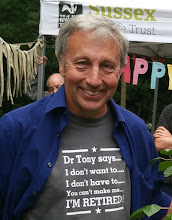This could be one of the biggest jumps forward for nature conservation for decades so I will devote several blog posts to it over the next few weeks. If you plan to do only one thing for nature in the next decade then engagement with the White Paper should be that thing! So please watch these posts – I’ll do my best to provide what information and guidance I can (from my own particular bias of course).
A new Natural Environment White Paper could be the biggest move forward for the environment since the National Parks and Access to the Countryside Act of 1949. It was this, and other changes around the same time, that set the scene for all that followed. There were improvements in the 1960s, in 1981 with the Wildlife and Countryside Act (the first time Sites of Special Scientific Interest received formal protection) and with the Countryside and Rights of Way Act in 2000. But the major stimulus came from forward looking people and an initiative that started in 1941.
The staggering thing about this is that Britain was busy doing other things in the early 1940s! Yet people of vision still found time to stimulate some of the most fundamental changes in the way we look after nature. The economic woes of today are a pin-prick in comparison to the problems the UK had in the 1940s so we have no excuse for not taking forward the job that was started all those years ago.
It is likely that there are 3 main drivers behind the push for a new Natural Environment White Paper:
An international study called “The Economics of Ecosystems and Biodiversity” (TEEB).
The UK National Ecosystem Assessment (UKNEA).
The Lawton Review on Britain’s ecological network – “making space for nature”
I will look at each one of these in turn in later blog posts.
However, also behind the White Paper was the lobbying of the Non-Government Organisations, in particular the Wildlife Trusts.
Before the election we stressed the need to move on to all political parties. Although things can always improve, current approaches are good at protecting the best of what we have. There have been further improvements with the development of Biodiversity Action Plans where the emphasis was on improving and expanding as well as conserving. However, any restoration has been far too slow to effectively halt damage to wildlife and rebuild the losses of past decades.
We have failed to meet the national objective of halting the loss of biodiversity by 2010. There is now a new target for the whole of Europe which aims to halt the loss of biodiversity and the degradation of ecosystems by 2020. More of the same is not an option. It is clear that a step-change is needed in our approach to the natural world.
We therefore pushed for a major shift from government (whoever got in after the election) and this White Paper is the response.
http://ww2.defra.gov.uk/our-responsibilities/nat-environment/
The nature of the discussion document “An invitation to shape the Nature of England” gives the impression that some of the messages are sinking in. For decades we’ve had to put up with decision-makers treating the environment as a “nice to have” – something very much in the background against more serious matters like making money. Now, however, the discussion document talks about how the natural environment underpins our prosperity, health and well-being. The questions invite us to think about how we embed the true value of nature in decision making, how we manage natural systems more effectively, reduce our ecological footprint and how we can think big and take a landscape-scale approach to managing our natural assets.
Maybe there is hope. Maybe someone’s been listening to us!
In future blog posts I will look at each of the major drivers behind the White Paper.

1 comment:
We do tend to have the most parochial conservation outlook. I just wonder whether the Lawton report will reflect on the evidence of ecological networking in continental Europe and elsewhere. Thus 15 countries across Europe have incorporated ecological networks into legislation for their national protected area systems, others as have it as national policy. But then we don't have a "national" protected area system, unlike 27 countries across Europe that have incorporated IUCN categories into their protected area legislation, and have state ownership as the basis of category I and II areas in their national system.
Post a Comment